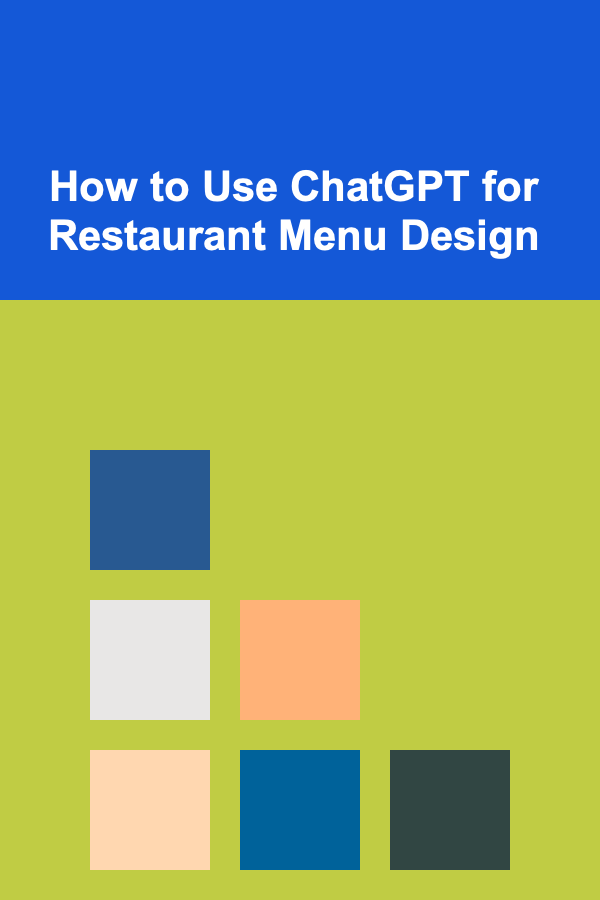
How to Use ChatGPT for Restaurant Menu Design
ebook include PDF & Audio bundle (Micro Guide)
$12.99$11.99
Limited Time Offer! Order within the next:

Designing a restaurant menu is no small feat. It involves balancing culinary creativity with an understanding of consumer psychology, marketing strategies, and the overall brand identity of the restaurant. A well-designed menu can influence customer choices, increase sales, and elevate the dining experience. With the rise of artificial intelligence (AI), particularly language models like ChatGPT, restaurant owners and chefs now have an innovative tool to assist in the menu design process.
In this article, we will explore how ChatGPT can be used for restaurant menu design, covering everything from brainstorming ideas to writing descriptions, incorporating pricing strategies, and optimizing for customer experience. By leveraging ChatGPT's capabilities, restaurant operators can enhance their menu design process, ensuring that their offerings not only look appealing but also align with their brand's vision and customer preferences.
Understanding the Importance of Menu Design
Before delving into how ChatGPT can be integrated into the menu design process, it's essential to understand the crucial role that menu design plays in the success of a restaurant.
1. Menu as a Marketing Tool
The menu is often the first interaction a customer has with a restaurant. It serves as both a reflection of the restaurant's identity and a powerful marketing tool. A thoughtfully designed menu can help convey the restaurant's theme, atmosphere, and the type of dining experience customers can expect.
The design elements---such as fonts, colors, images, and layout---communicate the vibe of the restaurant, whether it's upscale, casual, trendy, or family-oriented. Additionally, the items and descriptions on the menu can influence customer decisions. For example, the way a dish is described or its placement on the menu can steer customers toward higher-margin items or featured dishes.
2. Psychology of Menu Design
The psychology of menu design goes beyond just aesthetics. Certain principles of menu psychology are applied to optimize customer choices, and these can significantly affect the restaurant's profitability. For example, placing high-margin items at the top of the menu or using descriptive language to make dishes sound more appealing are common tactics.
Understanding these principles can help restaurant owners and designers use their menus strategically. A well-crafted menu design ensures that the customer is presented with options that cater to their desires while maximizing profitability for the restaurant.
How ChatGPT Can Assist in Restaurant Menu Design
ChatGPT, with its advanced language generation capabilities, can play a significant role in various aspects of the menu design process. Here's how it can help:
1. Brainstorming Menu Items and Concepts
Creating a menu that aligns with your restaurant's concept and culinary focus is the first step in the design process. ChatGPT can assist in generating unique menu item ideas based on various parameters such as:
- Cuisine Type: Whether it's Italian, Mexican, vegan, or fusion cuisine, ChatGPT can suggest menu items that match the restaurant's theme.
- Target Audience: The model can tailor suggestions based on the demographic the restaurant is targeting, from young professionals to families with children or health-conscious eaters.
- Ingredient Preferences: For restaurants with a focus on local or seasonal ingredients, ChatGPT can provide ideas that incorporate these elements into the menu.
- Dietary Restrictions: Whether it's gluten-free, dairy-free, keto, or vegan dishes, ChatGPT can generate menu ideas that cater to specific dietary needs.
By inputting your restaurant's niche, cuisine style, or target audience, ChatGPT can generate a wide variety of potential dishes that fit your criteria. This can provide the inspiration needed to build a diverse and appealing menu.
2. Writing Engaging Menu Descriptions
Menu descriptions play a vital role in enticing customers to try a dish. A well-crafted description can make a dish sound more appealing, heighten anticipation, and help customers visualize the flavors they are about to experience. ChatGPT can assist in writing these descriptions by:
- Highlighting Key Ingredients: ChatGPT can focus on the primary flavors and ingredients of a dish, making sure customers understand what they will be eating. For example, instead of just writing "Grilled Chicken Salad," ChatGPT can craft a more enticing description like "Juicy grilled chicken served atop a bed of fresh, crisp greens, tossed in a tangy balsamic vinaigrette with roasted almonds and goat cheese."
- Focusing on Sensory Language: Sensory language engages the reader's senses, making them imagine the textures, flavors, and aromas of the dish. ChatGPT can help add adjectives that describe taste, texture, and aroma, enhancing the customer's experience before they even take a bite.
- Communicating the Dish's Story: Many restaurants thrive on telling the story behind their dishes, whether it's a family recipe, a local tradition, or an innovative new creation. ChatGPT can help craft these narratives in a way that resonates with customers and enhances the emotional connection to the dish.
3. Menu Categorization and Organization
Menu organization plays a crucial role in how customers interact with the menu and make decisions. ChatGPT can assist in structuring the menu by categorizing dishes based on:
- Course Structure: Creating categories like appetizers, main courses, sides, and desserts helps customers navigate the menu easily.
- Ingredient-Based Groupings: Dishes can also be grouped based on common ingredients, such as vegetarian, seafood, or meat-focused categories. This helps customers with dietary preferences quickly find what they want.
- Specialty Menus: For restaurants with gluten-free, vegan, or other specialty options, ChatGPT can help organize these sections clearly, making it easier for customers with specific needs to find suitable choices.
4. Optimizing Pricing Strategy
Setting the right prices for menu items is a delicate balancing act. While ChatGPT cannot directly set prices, it can assist by:
- Providing Price Range Suggestions: Based on the type of dish (e.g., appetizers vs. main courses), ChatGPT can help generate general pricing suggestions according to industry standards or the restaurant's target market.
- Highlighting High-Margin Items: ChatGPT can help identify items that have a higher profit margin based on ingredient costs and preparation time, allowing the restaurant to focus on these items for better profitability.
- Creating Price Anchors: By offering a range of prices with a focus on high-value items, ChatGPT can help create price anchors---where higher-priced items make the mid-range options seem like better deals, subtly influencing customer choices.
5. Incorporating Seasonal and Promotional Changes
Menus are not static; they need to evolve with seasonal ingredients, promotions, and customer preferences. ChatGPT can be used to assist with:
- Seasonal Menu Ideas: As the seasons change, ChatGPT can help suggest new dishes that incorporate seasonal ingredients, such as spring vegetables or autumn spices. This keeps the menu fresh and exciting for regular customers.
- Promotional Menu Descriptions: For special events, holidays, or limited-time offers, ChatGPT can generate compelling promotional descriptions. These can highlight seasonal offerings, exclusive deals, or collaborations that encourage customers to try something new.
- Menu Testing and Adjustments: ChatGPT can assist in drafting variations of menu items based on customer feedback or sales data. If a particular dish is underperforming, ChatGPT can suggest tweaks in the description or ingredients to make it more appealing.
6. Creating Consistency with Brand Identity
Every restaurant has a brand identity, whether it's casual, sophisticated, or quirky. The tone and language of the menu should reflect this identity. ChatGPT can assist in:
- Adopting the Right Tone: Depending on the restaurant's branding, ChatGPT can generate descriptions in a formal, casual, humorous, or even adventurous tone. This ensures consistency across the menu and other marketing materials.
- Matching Visual Design: By using language that complements the visual elements of the menu, ChatGPT can help create a cohesive experience. For example, for a rustic farm-to-table restaurant, the descriptions might evoke imagery of fresh produce or traditional cooking methods, enhancing the design.
- Aligning with Cultural Themes: If a restaurant embraces a specific cultural theme, ChatGPT can help incorporate cultural nuances, cooking techniques, and local flavors into the menu descriptions, ensuring authenticity and customer engagement.
7. AI-Driven Feedback and Adjustments
ChatGPT's ability to quickly generate and revise content means that restaurant owners can easily make changes to the menu in response to customer feedback or sales performance. This adaptability is vital for:
- Testing Different Menu Formats: Whether it's adjusting the layout or tweaking the descriptions to see what resonates best with customers, ChatGPT can rapidly provide alternative options.
- Evaluating Customer Sentiment: By generating customer-facing content, ChatGPT allows for rapid iterations based on customer sentiment and feedback, making it easier to refine the menu over time.
Conclusion
ChatGPT offers an exciting array of possibilities for restaurant menu design, enabling chefs, restaurant owners, and designers to create menus that not only look visually appealing but also engage customers emotionally and intellectually. By leveraging ChatGPT's capabilities for brainstorming ideas, writing descriptions, structuring the menu, setting prices, and maintaining consistency with brand identity, restaurant owners can craft a menu that maximizes both customer satisfaction and profitability.
By integrating AI into the design process, restaurants can save time, enhance creativity, and stay ahead of trends, ultimately leading to an elevated dining experience for their customers.
Reading More From Our Other Websites
- [Home Maintenance 101] How to Maintain Your Home's Tankless Water Heater
- [Organization Tip 101] How to Organize Office Supplies by Project
- [Home Budget 101] How to Find Free or Low-Cost Entertainment Options
- [Home Family Activity 101] How to Organize a Family Baking Day at Home
- [Organization Tip 101] How to Use Clear Bins for Easy Fitness Equipment Storage
- [Ziplining Tip 101] Harness Up! How to Choose the Perfect Zipline Harness for Safety and Comfort
- [Home Renovating 101] How to Update Windows for Style and Efficiency
- [Organization Tip 101] How to Declutter Pet Supplies Regularly
- [Beachcombing Tip 101] Sea Bean Species Spotlight: How to Differentiate the Most Common Varieties
- [Soap Making Tip 101] Girl Power in the Workshop: Building a Small-Scale Soap Business as a Woman Entrepreneur

How to Create a Spring Cleaning Checklist for Your Car
Read More
How to Develop a Mindful Exercise Routine
Read More
How to Implement a Daily Cleaning Routine for Your Office
Read More
How to Make Use of Unused Space in Your Home for Storage
Read MoreHow to Sell Digital Productivity Trackers: A Step-by-Step Guide
Read More
10 Tips for Sales Managers New to Leadership Roles
Read MoreOther Products

How to Create a Spring Cleaning Checklist for Your Car
Read More
How to Develop a Mindful Exercise Routine
Read More
How to Implement a Daily Cleaning Routine for Your Office
Read More
How to Make Use of Unused Space in Your Home for Storage
Read MoreHow to Sell Digital Productivity Trackers: A Step-by-Step Guide
Read More